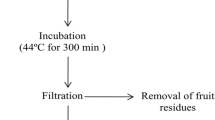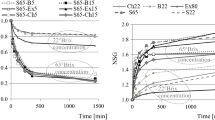Abstract
Juices from two varieties of cactus pear, a green (Opuntia ficus-indica) and a red (Opuntia streptacantha), were obtained and concentrated by evaporation. Both fruit varieties and their juices at different concentrations were characterized. Green cactus pears had significantly higher amount of pulp than red cactus pears; the peel of O. ficus-indica represented only 38 versus 52 % of the fruit for the O. streptacantha. Both varieties had no significant differences on moisture, density, pH, and titratable acidity, in contrary to soluble solids. Juice was concentrated under vacuum conditions to reach a final concentration of 42, 53–55, and 58–60 °Brix, respectively, and stored under refrigeration (10 °C) during 4 weeks. Physicochemical properties of the pears and juices were determined as fresh items (time zero) and every week for the concentrate juices through storage; similarly, flow parameters were measured at 10 and 25 °C. Concentrate density (1160–1283 kg/m3) was mainly affected by final soluble solids, while pH and acidity were affected differently depending on the variety. Concentrated juices at 42 °Brix were considered with Newtonian behavior with a viscosity of 2–22 mPa s, while those at higher concentrations were of pseudoplastic nature (n < 1.0 and K > 69 mPa sn). Power Law model fitted better the flow behavior than Herschel-Bulkley model of concentrates of both varieties. Temperature, solid concentration, and/or storage time affected the consistency coefficient (K) and flow index (n) depending on the cactus pear variety. Overall, those concentrated juices from O. streptacantha were more stable and exhibited lower apparent viscosity.




Similar content being viewed by others
References
Akbulut, M., Çoklar, H., & Özen, G. (2008). Rheological characteristics of Juniperus drupacea fruit juice (pekmez) concentrated by boiling. Food Science and Technology International, 14(4), 321–328.
Angulo-Bejarano, P. I., & Paredes-López, O. (2012). Nopal: a perspective view on its nutraceutical potential. In Hispanic foods: chemistry and bioactive compounds (H. M. Tunick and E. González de Mejía, eds.) pp. 113–159): American Chemical Society.
AOAC (2000). Official methods of analysis, AOAC International (17th ed.). Gaithersburg: AOAC International.
Argaiz-Jamet, A. (1999). Conservation and stability of prickly pear (Opuntia amyclae) preserved by combined methods. Basic and technological studies leading to a better utilization of prickly pear (Opuntia amyclae). Mexico: CONACyT.
Cepeda, E., & Villarán, M. C. (1999). Density and viscosity of Malus floribunda juice as a function of concentration and temperature. Journal of Food Engineering, 41(2), 103–107.
Chavez-Santoscoy, R. A., Gutierrez-Uribe, J. A., & Serna-Saldívar, S. O. (2009). Phenolic composition, antioxidant capacity and in vitro cancer cell cytotoxicity of nine prickly pear (Opuntia spp.) juices. Plant Foods for Human Nutrition, 64(2), 146–152.
Chen, W. Z., & Hoseney, R. C. (1995). Development of an objective method for dough stickiness. LWT—Food Science and Technology, 28(5), 467–473.
Del-Valle, V., Hernández-Muñoz, P., Guarda, A., & Galotto, M. J. (2005). Development of a cactus-mucilage edible coating (Opuntia ficus indica) and its application to extend strawberry (Fragaria ananassa) shelf-life. Food Chemistry, 91(4), 751–756.
El-Gharras, H., Hasib, A., Jaouad, A., & El-Bouadili, A. (2006). Chemical and physical characterization of three cultivars of Moroccan yellow prickly pears (Opuntia ficus-indica) at three stages of maturity. CyTA Journal of Food, 5(2), 93–99.
FAO (1995). Agro-ecology, cultivation and uses of cactus pear. Rome: FAO Plant Production and Protection.
Felker, P., Rodriguez, S. D. C., Casoliba, R., Filippini, R., Medina, D., & Zapata, R. (2005). Comparison of Opuntia ficus indica varieties of Mexican and Argentine origin for fruit yield and quality in Argentina. Journal of Arid Environments, 60(3), 405–422.
Fernández-López, J. A., Almela, L., Obón, J. M., & Castellar, R. (2010). Determination of antioxidant constituents in cactus pear fruits. Plant Foods for Human Nutrition, 65(3), 253–259.
Feugang, J. M., Konarski, P., Zou, D., Stintzing, F. C., & Zou, C. (2006). Nutritional and medicinal use of cactus pear (Opuntia spp.) cladodes and fruits. Front Biosciences, 11(1), 2574–2589.
Flores-Valdez, C., & Corrales-García, J. (2003). Cladodes and cactus pear: production, marketing, postharvest and industrialization. Mexico: CIESTAAM–Programa Nopal. Universidad Autónoma de Chapingo.
Fuentes-Rodríguez, J., & Lopez-González, J. (2004). The cactus as fodder in northern Mexico. In E. F. G. R. Valdez-Cepeda & S. Méndez-Gallegos (Eds.), The cactus: current issues. Mexico: Universidad Autónoma de Chapingo.
Gundurao, A., Ramaswamy, H. S., & Ahmed, J. (2010). Effect of soluble solids concentration and temperature on thermo-physical and rheological properties of mango puree. International Journal of Food Properties, 14(5), 1018–1036.
Hernández, M. S., Martínez, O., & Fernández-Trujillo, J. P. (2007). Behavior of arazá (Eugenia stipitata Mc Vaugh) fruit quality traits during growth, development and ripening. Scientia Horticulturae, 111(3), 220–227.
Hobani, A. I. (1998). Rheological behaviour of date-water concentrates. Journal of Food Engineering, 36(3), 349–357.
Inglese, P., Basile, F., & Schirra, M. (2002). Cactus pear fruit production. In P. S. Nobel (Ed.), Cacti: Biology and uses. Berkeley, California: University of California Press.
Jiménez-Aguilar, D. M., Escobedo-Avellaneda, Z., Martín-Belloso, O., Gutiérrez-Uribe, J., Valdez-Fragoso, A., García-García, R., Torres, J. A., & Welti-Chanes, J. (2015). Effect of high hydrostatic pressure on the content of phytochemical compounds and antioxidant activity of prickly pears (Opuntia ficus-indica) beverages. Food Engineering Reviews, 7(2), 198–208.
Kabas, O., Ozmerzi, A., & Akinci, I. (2006). Physical properties of cactus pear (Opuntia ficus india L.) grown wild in Turkey. Journal of Food Engineering, 73(2), 198–202.
Kader, A. A. (2013) (August 30, 2013). Cactus (prickly) pear: recommendations for maintining postharvest quality. Retrieved 08/26, 2015, from http://postharvest.ucdavis.edu/PFfruits/CactusPear/
Kaya, A., & Sözer, N. (2005). Rheological behaviour of sour pomegranate juice concentrates (Punica granatum L.). International Journal of Food Science and Technology, 40(2), 223–227.
Kgatla, T. E., Howard, S. S., & Hiss, D. C. (2011). Colour stability of wild cactus pear juice. International Scholarty and Scientific Research & Innovation, 5(8), 435–440.
Kumoro, A., Retnowati, D., & Budiyati, C. (2011). Influence of temperature and solid concentration on the physical properties of noni (Morinda citrifolia L.) juice. Food and Bioprocess Technology, 4(8), 1482–1488.
Kuti, J. O. (2004). Antioxidant compounds from four Opuntia cactus pear fruit varieties. Food Chemistry, 85(4), 527–533.
Macdougall, D. B. (2002). Colour measurement of food: principles and practice. In D. B. MacDougall (Ed.), Colour in food-improving quality. Cambridge: Woodhead Publishing.
Magerramov, M. A., Abdulagatov, A. I., Azizov, N. D., & Abdulagatov, I. M. (2008). Pressure- and temperature-dependent density change of juices during concentration. Food and Bioprocess Technology, 1(3), 254–269.
Markus, R., Moßhammer, M. R., Stintzing, F. C., & Carle, R. (2006). Evaluation of different methods for the production of juice concentrates and fruit powders from catus pear. Innovative Food Science & Emerging Technologies, 7, 275–287.
Moßhammer, M. R., Stintzing, F. C., & Carle, R. (2006). Cactus pear fruits (Opuntia spp.): a review of processing technologies and current uses. Journal of Professional Association for Cactus Development, 8, 1–25.
Nindo, C. I., Tang, J., Powers, J. R., & Singh, P. (2005). Viscosity of blueberry and raspberry juices for processing applications. Journal of Food Engineering, 69(3), 343–350.
NOM-092-SSA1-1994. (2013). Official Mexican norm for aerobic bacterial count. Mexican Sceretariat of Health.
Piga, A. (2004). Cactus pear: a fruit of nutraceutical and functional importance. Journal of Professional Association for Cactus Development, 6, 9–22.
Reyes-Agüero, J. A., Aguirre-Rivera, J. R., & Carlín-Castelán, F. (2004). Morphological variation analysis of 38 Mexican variants of Opuntia ficus-indica (L.) Miller. In G. Esparza-Frausto, R. D. Valdez-Cepeda, & S. J. Méndez-Gallegos (Eds.), El nopal, topicos de actualidad (pp. 21–47). Chapingo: Universidad Autonoma Chapingo.
Reyes-Agüero, J. A., Aguirre-Rivera, J. R., & Flores-Flores, J. L. (2005). Morphological variation of Opuntia (Cactaceae) in relation to its domestication in the southern highlands of Mexico. Interciencia: Revista de Ciencia y Tecnología de América, 30(8), 476–484.
Robert, P., Torres, V., García, P., Vergara, C., & Sáenz, C. (2015). The encapsulation of purple cactus pear (Opuntia ficus-indica) pulp by using polysaccharide-proteins as encapsulating agents. LWT—Food Science and Technology, 60(2, Part 1), 1039–1045.
Saenz, C. (2000). Processing technologies: an alternative for cactus pear (Opuntia spp.) fruits and cladodes. Journal of Arid Environments, 46(3), 209–225.
Saenz, C. (2013a). Chemical composition and characteristics of Opuntia spp. In FAO (Ed.), Agro-industrial utilization of cactus pear. Rome: FAO Rural Infrestucture and Agro-industries Division.
Saenz, C. (2013b). Opuntias as a natural resource. In FAO (Ed.), Agro-industrial utilization of cactus pear. Rome: FAO Rural Infrestucture and Agro-industries Division.
Saenz, C. (2013c). Utilization of Opuntia spp. fruits in food products. In FAO (Ed.), Agro-industrial utilization of cactus pear. Rome: FAO Rural Infrestucture and Agro-industries Division.
Saenz, C., & Sepúlveda, E. (2001). Cactus-pear juices. Journal of Professional Association for Cactus Development, 4, 3–11.
SE. (1994). NOM-0920SSA1-1994. Mexican official norm. Goods and services. Aerobic bacterial plate count method. Mexico: Secretaria de Economía (SE) [Mexican Secretariat of Economy]
Stintzing, F. C., Herbach, K. M., Mosshammer, M. R., Carle, R., Yi, W., Sellappan, S., Akoh, C. C., Bunch, R., & Felker, P. (2005). Color, betalain pattern, and antioxidant properties of cactus pear (Opuntia spp.) clones. Journal of Agricultural and Food Chemistry, 53(2), 442–451.
Sumaya-Martínez, M. T., Cruz-Jaime, S., Madrigal-Santillán, E., García-Paredes, J. D., Cariño-Cortés, R., Cruz-Cansino, N., Valadez-Vega, C., Martinez-Cardenas, L., & Alanís-García, E. (2011). Betalain, acid ascorbic, phenolic contents and antioxidant properties of purple, red, yellow and white cactus pears. International Journal of Molecular Sciences, 12(10), 6452–6468.
Szczesniak, A. 1983. Physical properties of foods: what they are and their relation to other food properties. In Physical properties of foods (M. Peleg and E. B. Bagley eds.). Westport, CN: AVI Pub. Co.
Tansakul, A., Kantrong, H., Saengrayup, R., & Sura, P. (2012). Thermophysical properties of papaya puree. International Journal of Food Properties, 15(5), 1086–1100. doi:10.1080/10942912.2010.513467.
Tesoriere, L., Fazzari, M., Allegra, M., & Livrea, M. A. (2005). Biothiols, taurine, and lipid-soluble antioxidants in the edible pulp of Sicilian cactus pear (Opuntia ficus-indica) fruits and changes of bioactive juice components upon industrial processing. Journal of Agricultural and Food Chemistry, 53(20), 7851–7855.
Vélez-Ruiz, J. F. (2009). Rheological properties of vegetal fluids. In M. E. Sosa Morales & J. F. Vélez-Ruiz (Eds.), Food processing and engineering topics (pp. 3–34). NY, NY: Ed. Nova Science Publishers, Inc..
Vélez-Ruiz, J. F. (2014). Food products evaporation. In T. Varzakas & C. Tzia (Eds.), Food engineering handbook (pp. 369–426). Boca Raton: CRC Press.
Vélez-Ruiz, J. F., & Barbosa-Cánovas, G. V. (1998). Rheological properties of concentrated milk as a function of concentration, temperature and storage time. Journal of Food Engineering, 35(2), 177–190.
Yahia, E. M., & Mondragon-Jacobo, C. (2011). Nutritional components and anti-oxidant capacity of ten cultivars and lines of cactus pear fruit (Opuntia spp.). Food Research International, 44(7), 2311–2318.
Zainal, B. S., Abdul Rahman, R., Ariff, A. B., Saari, B. N., & Asbi, B. A. (2000). Effects of temperature on the physical properties of pink guava juice at two different concentrations. Journal of Food Engineering, 43(1), 55–59.
Zuritz, C. A., Puntes, E. M., Mathey, H. H., Pérez, E. H., Gascón, A., Rubio, L. A., & Cabeza, M. S. (2005). Density, viscosity and coefficient of thermal expansion of clear grape juice at different soluble solid concentrations and temperatures. Journal of Food Engineering, 71(2), 143–149.
Author information
Authors and Affiliations
Corresponding author
Rights and permissions
About this article
Cite this article
Díaz-Lima, C., Vélez-Ruiz, J.F. Effect of Solids Concentration on the Physicochemical and Flow Properties of Cactus Pear Juices of Two Varieties (Opuntia ficus-indica and Opuntia streptacantha). Food Bioprocess Technol 10, 199–212 (2017). https://doi.org/10.1007/s11947-016-1811-1
Received:
Accepted:
Published:
Issue Date:
DOI: https://doi.org/10.1007/s11947-016-1811-1




